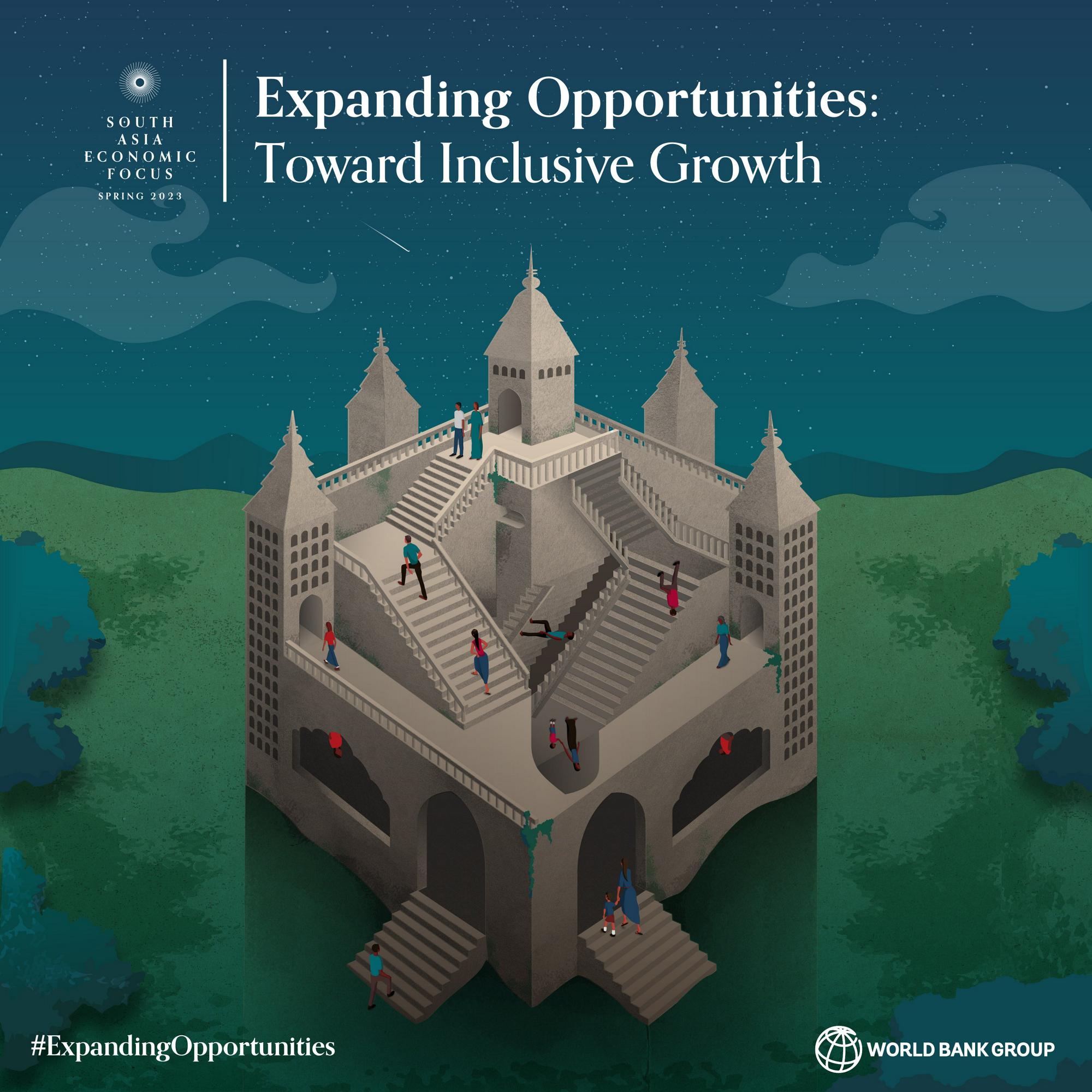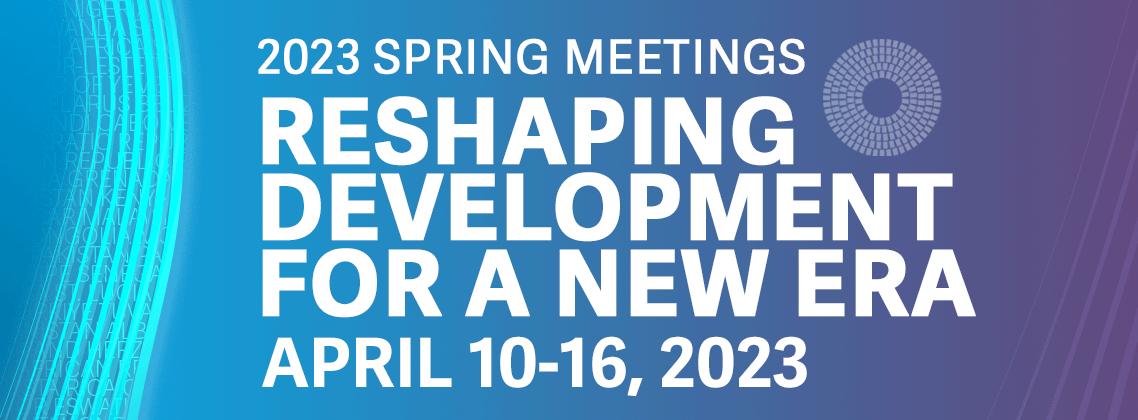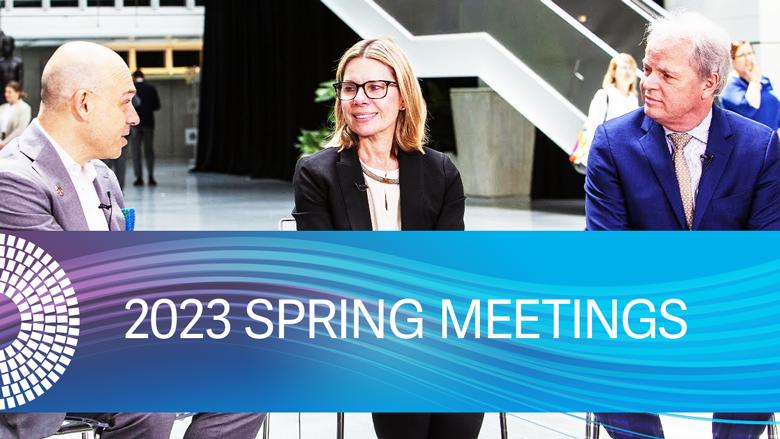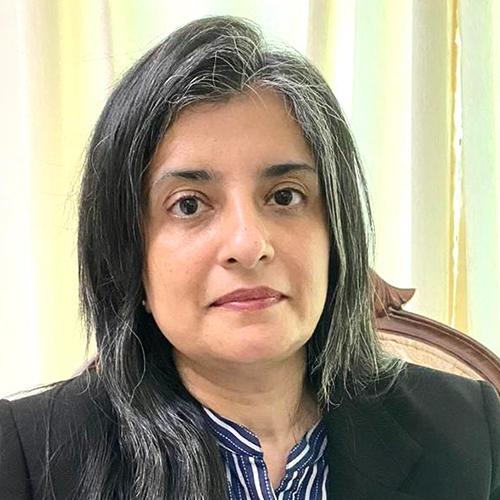South Asia’s Economic Outlook

South Asia’s Economic Outlook
- ABOUT THE EVENT
- AGENDA
- TRANSCRIPT
GO TO: SPEAKERS
What are the latest economic developments and growth prospects in South Asia? What opportunities does a stabilizing global economy create for the region? What challenges remain as countries still feel the impacts of major global and regional shocks? How can South Asia ensure more equitable growth?
The latest edition of the World Bank’s South Asia Economic Focus explores the current economic landscape and provides growth projections for the region, with a focus on inequality of opportunity and intergenerational mobility in South Asia.
Join experts from the region for a live discussion on how South Asian economies can expand opportunities and unlock progress.
Regional Economic update - Press release - Download the report
00:00 Welcome
01:43 Opening remarks
- Martin Raiser, World Bank Vice President for South Asia
09:20 Panel discussion
- Hans Timmer, World Bank Chief Economist for South Asia
- Poonam Gupta, Director General, National Council of Applied Economic Research
- Asma Hyder, Dean of School of Economics and Social Sciences, Institute of Business Administration
- Shantayanan Devarajan, Professor of the Practice of International Development, Georgetown University
- Moderator: Subina Shrestha, News Correspondent
1:00:45 Closure
[Subina Shrestha]
Namaste. Good morning, good afternoon and good evening to everyone watching and listening from around the world here on World Bank Live, through LinkedIn, Facebook and Twitter. A special thank you to all of you who have sent in questions. Join us on this conversation and please use #ExpandingOpportunities on your social media.
I'm Subina Shrestha, a filmmaker and a journalist from Nepal and your moderator for today. For the past two decades, I've covered South Asia as a journalist, mostly in my own country in Nepal and occasionally in the region. To be very clear, never as a financial journalist. To cover the region is to also cover natural and man-made disasters, desperate poverty and profound inequality. How does one begin to make opportunities equitable? How does one grow the economy and specifically ensure that there is upward mobility?
I'm here to try and understand from the great minds of this panel. It's not been a quiet time for South Asian economics. Pandemic, fuel prices, interest rates hiked by developed economies, all these have wreaked havoc to our economies and hit the people at the bottom the hardest. So today we'll discuss South Asia's Economic Outlook, a region that is home to 2 billion people. This is also the public launch of the semiannual report for South Asia, South Asia Economic Outlook. May I ask Martin Raiser, World Bank Vice President for the South Asia region, to give his opening remark and tell us what is going on and why? Do tell us what the report says.
[Martin Raiser]
Thank you so much, Subina. Hello and welcome, everybody, for joining us at this launch event. It's great to see many people tuning in from around the world through World Bank Live, through LinkedIn, Facebook, Twitter and other live streams.
Before I begin and summarize briefly the findings in this report, I did want to thank our wonderful moderator, Subina Shrestha, for agreeing to moderate this panel. I'd like to thank our Chief Economist for the South Asia region, Hans Timmer. I would like to welcome and thank the other panelists, Dr. Asma Hyder, professor and Dean at the school of Economics and Social Sciences at the Institute of Business Administration in Karachi, Dr. Poonam Gupta, who is the Director General at the National Council for Applied Economic Research and a member of the Economic Advisory Council to the Prime Minister of India, and Shanta Devarajan, who is a Professor of Practice at the International Development at Georgetown University.
Now for a brief summary of the report, over the past three years, South Asian countries have faced an unprecedented series of extreme shocks. The COVID-19 pandemic, a global economic slowdown, the economic impacts of Russia's invasion of Ukraine and natural disasters. The recovery from these shocks has been uneven and difficult, and in many countries, remains incomplete. Against this background, the past six months have brought a combination of good and bad news for South Asia, which are leading us overall to a moderating growth outlook. Among the positive developments are the following: global energy and fertilizer prices have fallen from their peaks, easing domestic inflationary pressures and reducing import bills, and reversing some of the large terms of trade shocks or losses that the economies of the region had suffered. The services sector, both tourism and business services, has continued in its strong recovery, and the reopening of China's economy has reduced disruptions in global value chains for goods and boosted global production potential. However, on the negative side, inflation in the advanced countries has proven much more persistent, and expectations for the path of monetary policy have had to be adjusted. This has caused jitters in financial markets and is negatively affecting risk sentiment. For South Asia, on balance, the tightening of global liquidity has clouded the outlook, given existing financial sector and balance of payments vulnerabilities. Rising global interest rates have caused capital flows from South Asia, capital outflows from South Asia, putting downward pressure on currency values and aggravating external debt pressures. Uncertainty in global financial markets, while so far without any noticeable contagion to South Asia, could further complicate external adjustment. Given weak fiscal and external buffers, policymakers in South Asia face difficult tradeoffs as they respond to pressures on their currencies. In the hope to stem depreciation, several countries have imposed quantitative restrictions on imports. These have negatively affected output and investment, and they can be circumvented and ultimately backfire as capital flows move to unofficial channels. It's important to note that not all SAR economies are as similarly vulnerable. India, for example, has been much less affected and is using the policy space to shift domestic spending towards investment. But for other countries in the region, the appropriate policy response to external pressures is an important point for debate, and I do look forward to hearing from our panelists on this. Now, against this backdrop, our latest South Asia Economic Focus report shows that growth in South Asia is now expected to slow in 2023. The South Asia region is expected to grow 5.6% this year, a half percentage point lower than expected half a year ago. Apart from Bhutan, the growth outlook has been adjusted downward for all countries. Fiscal adjustment is underway across the region, dampening the growth in consumption, although in some countries, public investment either continues at high levels, e.g. the Maldives, or is increasing in India. But public sector balance sheets on the whole remain fragile almost across the board.
Fiscal stimulus is thus not an option to support growth, so what instead should governments do? The answer is that after several years of extraordinary macroeconomic policies, the time has now come to put the emphasis on broad structural and fiscal reforms and turn back some of the extraordinary measures taken during the pandemic. In fact, the World Bank Research Department just published a global study on how to boost potential growth. Now, let me just focus on a few aspects that we emphasize in the South Asia Economic Focus. Countries should use the opportunity of lower energy prices and improving trade balances to move away from ad hoc measures, such as fuel subsidies and import restrictions, which distort the investment environment. Sustainable fiscal outlook must be at the center of the reform programs and will require not only reducing expenditures, but also, and importantly, increasing revenues. In some countries, notably Sri Lanka and Pakistan, adjustment will not be feasible without additional external support, but too many IMF programs have failed in both countries because of insufficient domestic revenue mobilization. The present crisis should be an opportunity for real change. This can only be achieved by broadening the tax base, which means more people should be given opportunities to participate in the productive economy. In previous issues of the South Asia Economic Focus, we have analyzed why female labor force participation is exceptionally low, and why so many people are stuck in unproductive informal sector jobs in South Asia, both of which keep the tax base extraordinarily low. In this new report, we provide further evidence that South Asia's production potential is not fully utilized. In South Asia, inequality of opportunity is significantly larger than in other regions of the world and intergenerational mobility is low. Education and labor market outcomes in South Asia are determined by factors outside the control of individuals, like the education of parents, where they were born, caste and other circumstances. This inequality of opportunity is not only unfair, but also inefficient. It prevents an optimal allocation of resources and reduces incentives to accumulate human capital, with a result of derailing the long-term economic growth outlook. To go from recovery to sustained growth, therefore, South Asia needs to ensure that economic development is inclusive. This is not just the long-term agenda, but should be a central part of the current reform programs that aim to make the fiscal outlook more sustainable. With that, I will turn the floor back to Subina to lead our distinguished panel in what I am sure will be an insightful discussion. Thank you very much for joining us once again and I look forward to the debate.
[Subina Shrestha]
Thank you Martin for that overview. I was going to say, surprise, here's our stellar panel, but you've stolen my thunder there [laughs]. Now we're going to have a really exciting conversation ahead of us with Hans, Dr. Asma, Dr. Poonam and Shanta, and we have a few questions that other people have sent to us and I'm going to try and incorporate them over here. The first question I'm going to ask Hans. From what I understand from the report and from what Martin said as well, South Asia is facing multiple pressures at the same time, including vulnerabilities in the financial sector and persistent economic challenges. Yet recently a World Bank report said that South Asia had one of the highest potential growth rates in the world. What policies do you think would help South Asia get out of this prolonged crisis and reach that potential?
[Hans Timmer]
Thanks so much, Subina. It is not a surprise that in another report the conclusion was that growth potential in South Asia is among the highest in the world. First of all, in South Asia you see that the countries are on a sweet spot in the demographics. They are at the peak of demographic dividend. That means that the share of the population in working force age is very large. That increases potential, but also, when you are at the level of development that most of the countries in South Asia are, there's a huge opportunity to catch up in productivity to other countries in the world. The big problem that also Martin raised is that that potential is not fully utilized. That's not only because of the short-term problems that you just highlighted, but it's especially because of structural impediments. And as Martin said, we have analyzed in the past why female labor force participation is hardly more than 20% in the region. It has a lot to do with social norms, gender norms in the region, which makes it very difficult to increase female labor force participation even if you are able to give better education to girls. Currently, female labor force participation is still 20 percentage points below what it is in other countries with similar kinds of characteristics. Another problem is the very large and stubbornly large informal sector where people are not productive because they don't have access to credit, they don't have access to markets. As Martin said, what this report now shows is that inequality of opportunity is very high in South Asia, larger than in other countries, which means that the outcomes in education and in the labor market are to a large extent determined by factors that you don't have under control yourself. That's the education level of your parents, the education, the income level of your parents, the place where you were born. Ultimately, to achieve the growth potential that was described in the other reports just published by the World Bank, you need to make growth a lot more inclusive. It means more mobility in South Asia, more labor market mobility, and especially better access from people in the rural areas to the urban areas, because one conclusion in this report is that the opportunity in urban areas is better than in rural areas, and that's especially true for girls. To take away the bottlenecks in the labor market and to make it easier for people to move and to find their most productive place to work is an essential part of the reforms. It seems almost contradictory that the potential is so high, but at the same time, the underutilization of potential is also very high.
[Subina Shrestha]
It would be better if it was all equal by the science of it. Asma, the second question goes to you. First came the pandemic, and then came the rising energy prices and already weakened economies in our region were put under enormous pressures as the dollar strengthened. In hindsight, is there something countries could have done better to manage these multiple crises or are there more structural or long-term policy agendas that could help countries be better prepared for similar crises?
[Asma Hyder]
Thank you very much, Subina, for the question and many thanks to the World Bank for sharing the report and I found it very useful. The COVID-19 pandemic affected across the globe, and not limited to South Asian countries, but this region is very much prone to a different type of shocks and every country is actually fighting with a unique type of crisis. Say, for instance, Pakistan and Sri Lanka presently have a huge political crisis as well as economic crisis. Similarly, the climate change challenge, which has a significant impact on the economy and also, of course, on livelihood as well. India and Pakistan, for instance, are facing quite significant extreme weather, Bangladesh on the rise of the sea level and Nepal has its own challenges because the glaciers are melting. These are linked to climate change, but as the report emphasized a lot on energy crisis which is very important and has huge impact on the household and also on the production of the industrial units. The obvious outcome, of course, is the increase in cost of production and it becomes more difficult for the businesses in this region to compete in the international market. There are a number of things that I can suggest, but I will focus on four things which I think are more important and I will also try to explain why they are more important. So one is that whenever there is a crisis, especially in the developing countries and also in this region particularly, is the food insecurity, which is very important. I think one of the important things that the government in this region needs to invest in is to improve the supply chain, to invest in more infrastructure and transportation and to remove all the hurdles that are done in the supply of the product while reaching the markets. We need to focus more on ensuring food security. The second is to invest more in the renewable energy in this region, because this region has a lot of potential in this particular sector and I think this is quite a low hanging fruit if we seriously consider it, I mean the investment in the renewable energy. The third thing, which I would like to hear from the panelists as well and the World Bank view on that as well, is basically the regional cooperation. Now I think it's the time that we seriously need to consider it, first, especially from the perspective of trade and say, for instance, particularly the trade of food items, India and Pakistan, considered the trade across border as a potential proposal for both countries. This is actually a win-win situation for these two countries and also for the region. Besides trade, the regional cooperation, we considered the sharing the information of the best practices and investment in each of the countries and also in infrastructure development. Finally, I think another important thing which we consider as a long-term investment to address the different types of crises is basically the climate change adaptation. Our government in the region should initiate different programs to help farmers and also the entrepreneurs to adapt to the changing climate and should be ready for that. The producers should be equipped with the new innovative methods and be aware of the outcome of climate change and its consequences. I think these four are one of the major priority areas we may consider to address the challenges in the region. I’ll stop here and later I’ll come back as the discussion evolves.
[Subina Shrestha]
Thank you so much, Asma. Shanta, if I may ask you, so many countries in the region have rolled back some of the supportive policies implemented during the Pandemic, including loan moratoria, expanded food and work programs, and food and energy subsidies. Given the high food inflation and slow income growth in the region and economic crisis in some countries, do you think these policies were rolled back too soon, or maybe even not quickly enough?
[Shanta Devarajan]
Thank you, and it's very nice to see everybody and join this distinguished panel. I actually think that energy subsidies in the region are a symptom of a broader disease in South Asia, which is that policies are geared towards the elites. Fuel subsidies and energy subsidies primarily benefit the rich because they're the ones who consume the most fuel and electricity. Indeed, it's even worse than that because the amount of money that is spent on these subsidies is actually taking away from money that could be spent on the poor. You're telling poor people, if you want to get a benefit from the state, you have to consume fuel. Compare that to providing targeted cash transfers to the poor. This is a pervasive problem, but it's not the only problem, let me just add that there's a whole host of policies, similar to the ones that Hans and Martin were alluding to, that not only are needed to enable South Asia to achieve its potential growth that we were talking about earlier, but are actually aimed at making growth more inclusive. The energy subsidies won, but let me just mention a few others. Agricultural policy in the region is geared towards the rich. The fertilizer subsidies benefit large farmers, not the smallholder farmers. Then India has this policy of free power to farmers, the South Indian states, which is depleting the water table, and again, benefits the large farmers. Sri Lanka has a policy which forces farmers to grow paddy rice, which is the least lucrative crop. 50% of those farmers are poor because they don't have the choice of what to grow. There's a whole series of these policies that need to be reformed, and, a couple of people have mentioned domestic resource mobilization taxation. Absolutely true that the region has very low levels of taxation. I think the average is about 11% of GDP or something like that, and Sri Lanka is even lower than that. But the trouble is people don't want to pay taxes unless they think they're going to get something from it. It's the poor quality of public services on the other side that is preventing them from actually raising the taxes. We have to actually do something about public services, including education and health. I might add that I think the report is a little optimistic. In order to improve education, which is clearly needed, you just have to have more public investment in education. We've done that before and it hasn't worked. So we have a lot more to do to improve the quality of education in South Asia than just simply increasing public investment. But we need to do it if we want to raise taxes, if we want to convince the public that it's worth paying higher taxes in order to get the returns. Of course, to address the problems about intergenerational transmission of education as well as the inequality of opportunity, all of which are serious danger signs for a region that has had a long history of ethnic conflict, religious tensions and this elite capture.
[Subina Shrestha]
Thank you so much, Shanta, that's absolutely fascinating. I mean, it sounds like we are quite self-destructive in many ways with bad policies, as well as being really vulnerable, being an emerging market. Thank you so much, it's really informative. My next question goes to Dr. Poonam. In the past couple of years, we've seen the US and other advanced economies raise interest rates. At the same time, we've seen countries in our region, Bangladesh, Sri Lanka, Pakistan, struggling with falling foreign reserves and depreciating currencies. To what extent do you think interest rate increase contributed to the current external sector crisis in the region?
[Poonam Gupta]
Thank you, Subina, for that question. I’m really happy to be on this panel. Let me take a minute to define and describe my framework in order to answer that question.
When I look at the region, I look at three kinds of countries. One is India, which is the largest country, and one can call it also a large emerging market, and it's important to remember that India is a large emerging market. Then we have the next three largest economies, Bangladesh, Pakistan and Sri Lanka, which are really the frontier economies when it comes to how they are perceived in the market for finance internationally. The remaining four are relatively small economies, Bhutan, Nepal, Maldives and Afghanistan.
This particular challenge that you just discussed, rising interest rates in the US and other advanced economies, have a first-order impact on large emerging markets such as India. They do not have a first-order impact on frontier markets or the smaller economies, the rest, seven in the region, three and four. But this is not to say that the region does not get impacted by the global shocks or global conditions, they do. Some of them we have already discussed, but let me still reiterate them.
Let me look at three kinds of shocks which happen globally and which impact countries in the region. One is global growth. The outlook has been subdued, the last three years, it has not recovered fully. There have been multiple crises as we have been hearing about, COVID-19 Just as COVID-19 was retreating, there was a war, a Russia-Ukraine war, and this entrenched very high inflation in the US and other advanced economies. There have been three crises on the back of each other. The first-order impact of these have been through global growth, which has impacted all countries in the region, including the three you mentioned, Bangladesh, Sri Lanka and Pakistan. The export demand slows down because of this global growth shock. The second shock is to energy prices. The region is a net energy importer and they get impacted, all of them get impacted, when energy prices increase, which they did increase in the wake of the Russia-Ukraine war. Third challenge is high inflation in advanced economies and the fact that they tighten their monetary policy in order to respond to that high inflation.
Now, as I said, its first-order impact is only on the large emerging markets, which is India in the region along with other similar economies in the world, Indonesia, Brazil, Turkey. It does not directly impact Sri Lanka, Pakistan and Bangladesh. But then how do we explain the situation that you described, the falling reserves and their exchanges depreciating and all three of them actually signing up for the new IMF program? I would say that advanced economies’ monetary policy has an impact on the margin in the short run. It does impact cost of financing and availability of investment financing in the medium term, but I would actually point to more structural factors which these economies have been really suffering from, if that's the right word. In order to prepare for this panel, actually, I looked at the history of programs with IMF, all these three countries, and the data I got is telling. The years I'm looking at are 1990 till the eve of the COVID-19 pandemic, 2019. 30 years of data. Pakistan has had eight IMF programs in these 30 years, has been in one program or the other for 22 years of these 30 years. Sri Lanka has had six IMF programs and I'm not even counting the programs that they are signing or will be signing in coming months. So six IMF programs, it has been in an IMF program for 17 years of those 30 years. Bangladesh has done relatively better, three IMF programs being in an IMF program for 10 years and seems to have graduated until the pandemic hit. At least for Pakistan and Sri Lanka, if not for Bangladesh, there seem to be deep structural factors which are at play, which are making the current situation look vulnerable. The real progress can be made, as Martin said, looking at the structural factors of their economies, the macroeconomic vulnerabilities and macroeconomic unsustainability. Advanced economies, policy rates, they do impact these economies, but not in the short run, that impact will come in the medium term when these high rates are sustained for, we don't know for how many years, but even if these rates are sustained for two years or so, then these economies will start seeing the impact of that shock as well. Thank you.
[Subina Shrestha]
Thank you very much, Dr. Poonam. Shanta, did I see that you wanted to respond to it? Or… No, okay. Because I thought you wanted to respond to it for some reason.
[Shanta Devarajan]
Oh, I agree with everything she said.
[Subina Shrestha]
Okay. I thought you wanted to respond. Sorry. This question, I'm going to throw it to every one of you, all three of you. The report highlights that over the 20 years of sustained growth, poverty has reduced significantly, yet inclusive social progress has not been delivered. As you've heard both from Martin and Hans [unintelligible], South Asia remains a region with the lowest intergenerational mobility in education and high levels of inequality in opportunity. Do you think that lack of social mobility is linked to the type of growth in the region or the experience that a country has in terms of low export orientation, leapfrogging industrialization, politically connected firm? Or is it linked to some other factors such as patriarchal social norms, in the case of women's exclusion from labor markets that we talked about earlier? Someone else has thrown a similar question that can tag onto it. Given that South Asia has a very low female labor force participation, what macroeconomic policies need to be changed to improve women's paid work outside of home? Shanta, since you have to leave soon, would you be able to start that? Then we can go to Poonam and ask after that.
[Shanta Devarajan]
Sure. By the way, I don't have to leave because I already came to my classroom [laughs].
[Subina Shrestha]
Oh, okay.
[Shanta Devarajan]
The students will start wandering in in a few minutes.
[Subina Shrestha]
Okay, all right then.
[Shanta Devarajan]
Yes, thanks for that question. I think it's really the fundamental question. I think the deep divisions, the ethnic tensions, the religious tensions, the discrimination, the caste discrimination, the gender discrimination that seem to be pervasive in South Asia has contributed immensely to the widening inequality in the presence of growth. Just to give you a couple of examples, Sri Lanka, which was considered this paragon of social welfare and high human development indicators, has one of the highest levels of inequality in South Asia today. Why? Well, they had a civil war, a 26-year-long civil war between two ethnic groups, the Tamils and the Sinhalese. During that period, the war was fought in the North and the East. Meanwhile, the richest province in Sri Lanka, the western province, boomed because that was a period following trade liberalization and opening up of the economy. the western part, the area around Colombo, was actually growing very rapidly. But if it was the richest province to begin with, and it grew the fastest, you can see what that does to inequality. That's that inequality that we're facing. It's the same thing with caste discrimination in India, and increasingly, and what concerns me is the discrimination and persecution of Muslims that is increasing in India. We are seeing that. In fact, one of the studies, Sam Asher's study on intergenerational mobility points out that for low-income groups, intergenerational mobility has been increasing for every group but the Muslims. The Muslims is the one where intergenerational mobility is declining. That's very scary in a situation where this group of people are also being discriminated against. The caste discrimination that we observe, which has, by the way, spread to Silicon Valley in California, is also a source of concern. The evidence has come from this report where you see that inequality of opportunity is lower in urban areas rather than rural areas. We know that caste differences are less pronounced in the urban areas. The people who move there, sometimes they move there just in order to avoid caste discrimination. These underlying cleavages, the ethnic caste, the religious, has definitely made it possible for South Asia to grow rapidly and also become more unequal.
[Subina Shrestha]
Dr. Poonam, would you like to take that on, please?
[Poonam Gupta]
Sure, Subina. If I understand your question correctly, it has three different parts.
One is weak intergenerational mobility in income, relating it to weak international, or intergenerational mobility in education. It's coming from chapter three of the South Asia Economic Focus, which in fact is a very good chapter, very powerful, a lot to learn from it, as I did this morning. The second part is gender, participation of women in the labor force, which, interestingly, is a very unique feature of our region across countries. India may be a large emerging market, but suffers from this phenomenon as much as the frontier markets in smaller economies in my framework. The third is you are trying to relate it to the kind of growth drivers we have had in the region, which is that unlike other fast growing countries and regions, the region has still lagged behind in manufacturing and exports of manufacturing. This is the way I have understood the question, and this is, if you allow me, let me respond to that in a similar fashion.
There is no denying the fact that education is an important leveler, that education is needed to make societies more equal and to also participate and fuel the economic growth machinery. I would just like to expand the definition of education from numbers of years in school to quality of education, which South Asia Economic Focus has clarified, that quality of education is important. But let's stretch that a little bit more to skills that a student obtains when the child is learning in school or elsewhere. I think this definition of intergenerational access to education needs to be expanded too to access to skills. The future of jobs is changing. More and more activities are going to become more skill intensive and it's a good question to ask whether those skills are being learned by students and what is the right way. The other part is that women have not as yet contributed their fair share to growth and it's a question that the region is grappling with, it's a question that India is grappling with. There are many different components of that big challenge. There are issues related to social norms, there are issues related to fiscal and monetary policies and perhaps they can impact this, there are issues related to the nature of jobs that they can get. One small example is if cultural and societal norms are entrenched and hard to change in a short period of time, should one think of more, not necessarily flex jobs, but shorter duration jobs? For example, instead of a regular workday being eight hours or ten hours, can we think of six-hour work shifts? If we can be a little innovative on things such as those, we can move the needle faster. These are the conversations we have started to have in India. The other is urbanization, as the report very convincingly shows, that urbanization results in both, more gender participation in workforce but also better intergenerational mobility. Urbanization as a careful and thoughtful policy push can be a win-win. The last part of the question is whether these are the phenomena which are resulting in the drivers of growth in the region, which is more agriculture and services sector driven rather than manufacturing driven. I think there are many more challenges. These gaps that we discuss, intergenerational mobility being limited or women not participating, these gaps would show through the availability of labor, wage cost, limited entrepreneurial skills. But these are not the challenges we see in the region. Instead, the manufacturing sector is impacted more by other deep-rooted, long-standing challenges to growth, which is labor market regulations, land market availability and cost of credit, integration with the global economy, limited FDI. While I agree with you and the report that the challenges we just discussed are important, limited intergenerational mobility and limited participation of women in labor force, but in order to turn around the manufacturing sector, we need to work on many more issues, the issues which have persisted for all these decades despite a lot of policy action. Simultaneously, we need to continue to work on removing those impediments. I'll stop here.
[Subina Shrestha]
Thank you, Dr. Poonam. Can I ask the same question to Dr. Asma, please?
[Asma Hyder]
Yeah. Thank you very much, Subina.
The report actually is very eye-opening when it comes to the social mobility and it's one of the biggest challenges in the region as well. Also, no doubt, there is no question that it's a big hindrance in the growth process as well. The policy debate on the social mobility and inequality in opportunities is extremely important in the post-pandemic period. For instance, all those girls, those who are living in the far areas and also underdeveloped areas who were hardly making it to reach schools, now during the pandemic many of them have dropped out, so there is a very high probability that they will never be able to join again. We need to consider it very seriously and it will further reduce the social mobility, which is a very serious question.
This is the high time to think about an inclusive and better schooling for all social classes and gender, better health for all, to open the opportunities for everyone to tap into the potential in the region. For this, I would say that the government needs to change their priorities toward the inclusive education system, inclusive health system. As Poonam mentioned about the labor market frictions, that all the opportunities, the access to credit should be available to everyone, to a common man, and the system and the process should promote new and innovative ideas irrespective of their social class and gender. Now this is the time that we need to think about all these, about changing our priorities.
[Subina Shrestha]
Thank you so much, Asma. I'm really glad that everyone kind of agrees that things need to change and I think that kind of leads us quite flawlessly almost into the next question, is this pattern of non-inclusive growth sustainable? Where should policymakers focus to propel inclusive growth and respond to calls for redistribution? May I call upon Hans to answer this question first? [pauses] Hans, you're muted.
[Hans Timmer]
Apologies for that. The first observation is that there is no doubt that South Asian countries have to become more inclusive. It is important to address the short-term problems that the countries are facing at the moment. It's also important to materialize the long-term growth prospects.
We have discussed already a lot the fiscal base that has to be broadened. But I want to add to that, it is also important to increase more the social support, the population support for necessary reforms. It is really important to include the people also in the kind of reforms that are needed, especially now in Sri Lanka and Pakistan. Shanta said that many people are not willing to pay taxes because they don't get enough in return because of the bad quality of the services, because of elite capture, a lot of the expenditure is going to the rich, but there are positive signs also that actually people are willing to pay taxes if they see the returns. We have analyzed a lot what is happening with e-commerce platforms at the moment. Very small, informal firms have an opportunity to access markets. When they are selling their products on e-commerce platforms, the taxes are being paid because the platform is paying those taxes, and per unit, the people are getting less, but at the same time, their productivity increases because they can sell a lot more, and they are perfectly willing to pay those kind of taxes. There, you see, the problem is not in general with the attitude of the people, the problem is with the lack of opportunities. There are possibilities in the informal sector to include more people. That is true also for female labor force participation. You see interesting examples. I saw it myself in Pakistan, where informal women who are working from home and providing through middlemen at a very low price their products, they start organizing, circumventing the middlemen, increasing their income, often threefold, and then they try to register, and they're perfectly willing to pay taxes also, and at that moment they get support from their husband to work abroad. It is really essential to break through all the bottlenecks, to break through the current norms and to increase mobility, not just in an economic sense, but also to increase social cohesion. Because without social cohesion, the reform programs will not come off the ground or very quickly the governments will find themselves in the same problems that they started with.
[Subina Shrestha]
Thank you, Hans. Can I ask Poonam to answer the same question, please?
[Poonam Gupta]
Can you please repeat the question, Subina?
[Subina Shrestha]
The question was, is this pattern of non-inclusive growth sustainable? What should policymakers focus on to propel inclusive growth and respond to calls for redistribution?
[Poonam Gupta]
So it's a very profound question, and it's a question which sits among many other questions that policymakers in these countries are grappling with.
Let me actually, perhaps add to some of the things that Hans said. Not that I don't think this question is very important, and there are many different dimensions of inclusion. There is a gender element, there is a socioeconomic element, and there are other elements. Having said that, the report shows that there is absolute improvement in the living standards in the region. What we are really worrying about is the relative standard, not the absolute standard, which have been increasing very well. Relative standards are important, and education organization, can be two big levelers.
The next question we tried to address, or Hans tried to address, was about the fiscal room in order to deliver on this promise or on this priority. I wanted to actually endorse what Hans said. Digital has been such a big contributor to growth and equality in India, to actually help with this issue of informality that we are discussing, inclusion that we are discussing, it's much easier to now send money and help to those who deserve it in real time, to take out the inefficiencies from the system. When, for example, India in the region went ahead with this digital drive, I don't think anybody had in mind the kind of benefits that would come from it. We are learning, as we are going ahead, you know, with this greater digital footprint in the country, we ourselves are discovering the kind of benefits that can come.
Asma mentioned education and health. Again, digital is playing a great role in that. A couple of examples of the wider benefits that we are seeing is an increase in tax-to-GDP ratio. Shanta, you need to come back to the region, certainly you need to come back to India to update your data. Tax-to-GDP ratio, if I'm not wrong, is now 16% to 17%, gone are the days of 10% and 11%. All kinds of taxes, as Hans said, once you are into the formal system, there is no going back, you are in the formal system forever. E-commerce is playing that very significant role. The issue is important and it's very hard to crack. But urbanization, gender, digital, perhaps a combination of all three, can help us deliver on these challenges sooner than it need be the case. Thanks.
[Subina Shrestha]
Thank you, Dr. Poonam. Shanta, would you like to respond to the same question, please?
[Shanta Devarajan]
Sure, I was hoping you would ask me that question. Two things.
One is, I hear what Hans is saying, and he's absolutely right, that there are ways you can, with e-commerce, you can convince people that they will get a benefit from paying taxes, that they'll be willing to pay taxes. The problem in the region is the politicians, not the entrepreneurs or the people. The question is, can we get politicians to support these kinds of policies? Let me just give you two examples. The Free Power to Farmers policy in South India. There are innumerable studies of farmers’ willingness to pay for power. Something like 75% to 80% of farmers say they're willing to pay for power rather than get it for free. Yet, no politicians will stand for election in any of the southern states claiming that, if elected, I will eliminate the free power policies. On the contrary, they run on platforms saying, I will broaden the free power policy to more people in the state. The second example is taxation of agriculture in Pakistan, which has been a perennial problem for decades. Everyone agrees you need to tax agriculture in Pakistan. It's benefiting large landowners enormously. Yet, politically, it has been impossible to push that through. We can devise all sorts of clever electronic mechanisms to get people to pay taxes and make it easier and so on. The question is, are there going to be politicians who are willing to champion those? Rather than their traditional approach, which is basically a populist stance.
Now, more generally, when you ask about whether we should take this on, take on the inclusive growth, I would say this is essential. Reading chapter three of this report on inequality of opportunity, to me it's quite scary because this is a simmering crisis that the region is experiencing, where you have high inequality of opportunity and low intergenerational transmission or intergenerational mobility in education. The combination means that you could be caught in an inequality trap for a long time. I don't want to say something too controversial near the end, but let me say we've been there before in another region, which is the Middle East and North Africa. I remember, I was the Chief Economist there too, for the ten years before the Arab Spring in the MENA region, growth was high, poverty was low, inequality was relatively low and declining. Yet, in a period of about six months, the whole region just blew up with revolutions in four countries, some of which have descended into a civil war that is still going on and unrest, and increasing totalitarianism in several countries. This is the scenario that I fear, and when I see chapter three, I see the signs of what was going on in the MENA region in 2010. We have to do everything possible to avoid that calamity that the MENA region experienced.
Reforming these policies to promote inclusive growth is priority number one. I don't think we should let up on that. We should be relentless in trying to bring about these policy reforms that all three of us, four of us, have been outlining this hour, and because if we don't do it, the region could explode.
[Subina Shrestha]
Thank you so much, Shanta, I hope policymakers are listening to your warning. For a non-economics person, chapter three did make sense to me and it did kind of make my heart beat a little louder. Asma, would you like to add upon this question as well, please?
[Asma Hyder]
Thank you, Subina. I'm happy that we have a consensus at least on three things. That's why I mentioned the regional cooperation that we can learn a lot from each other’s experiences.
The first is, as Shanta mentioned, that the social fabric of the society is such that it is impacting a lot on the economic outcomes as well, especially the discrimination and the gender role, of course, need to be reconsidered. Third, the politician, that how much they are actually willing to take certain reforms and very ambitious initiatives.
I would like to add upon, especially from the perspective of Pakistan and maybe the other countries as well, is basically, for instance, to reduce, as we need to increase the fiscal spaces. The one thing that we can do is to reduce the current expenditure and the very important thing is to reduce the size of the government and to improve the efficiency of the government. That is very important in this region.
Second is to reduce our spending, especially for Pakistan and also for India, maybe to reduce the spending on defense and to improve the fiscal spaces. Another important thing is that usually, in most of the region, taxes are more of an indirect nature. The tax system needs to be fairer, and it should be based on income.
Finally, I would say that reforms are required in all sectors, especially when it comes to Pakistan, starting from judiciary and then governance, and in all sectors we need reform, and especially because, as Poonam already mentioned about the situation in Pakistan and Sri Lanka, we are going again and again to IMF.
The only solution we have in the long term is reforms. Unless the politicians are willing to do that, and it's definitely not a popular agenda, it's going to affect the ballot boxes, but somebody has to take it and it's difficult to do that, but reform seems the only solution.
[Subina Shrestha]
We have just a few minutes. There's been a question that's been sent by one of the audiences and I think I'm going to throw this to Shanta. What are the fundamental reasons for Sri Lanka and Pakistan showing least GDP growth and facing acute balance of payments crunch default? How do they compare to other South Asian countries? If you could just answer that within two minutes, please.
[Shanta Devarajan]
At least in the Sri Lankan case, they ran out of foreign reserves and had to default on their debt. There was no foreign exchange coming in, which meant that there were shortages of imported goods, food, fuel, pharmaceuticals and the economy contracted because there were just no imported inputs for production, so exports also contracted. It's a straightforward, and by the way, this is not due to COVID-19, this is due to misguided and I would say reckless policies by the previous government in Sri Lanka.
[Subina Shrestha]
Asma, would you like to add what happened in Pakistan? Because I think someone wants to know that.
[Asma Hyder]
Sorry, what was the question?
[Subina Shrestha]
The fundamental reason why Pakistan is showing least GDP growth, Pakistan and Sri Lanka are facing least GDP growth and facing acute balance of payment crunch default.
Asma Hyder
There are a few things in common between India and Sri Lanka and one is basically the elite capture and the politicians. Definitely, as I said, that we need reforms in almost every sector of the economy to reduce the labor market frictions and to face the facts that we have and to take the difficult decisions which are important at this point in time.
[Subina Shrestha]
Thank you so much. We're really closing in the times, we're running out of time. Dr. Gupta, would you like to add some of your final thoughts about this?
[Poonam Gupta]
Let me quickly take 40 seconds that are left to answer your last question.
It's a very text-book case of macroeconomic instability, and if you look at country after country, it's a similar narrative. Living beyond your means, fiscally, monetary policy not being independent, exchange rate being managed for some part and structural reforms being ignored. As I just narrated with the data, these have been long standing issues in the two countries that you mentioned, Subina, and it would require deep structural reforms over a period of time with a sound macroeconomic framework in order to get out of the situation. These two countries are not alone, there are a couple of other countries, Turkey, that Martin would know, also keeps going through that. These cases have become fewer than what we used to see in the 80s and 90s, but it's unfortunate that we still have a handful of countries which are still going through these cycles of crisis and then IMF program and recovery, only to go into a crisis again.
[Subina Shrestha]
Thank you so much for that, time just went so surprisingly fast. Thank you Asma, Poonam, Hans, Shanta and Martin for making this conversation so informative, engaging and lively for me, as well as everyone else.
For those of you who are still with us, thank you so much for joining in. Do keep the conversation going on with #ExpandingOpportunities and read the report at www.worldbank.org/southasiafocus and have a good rest of the day or evening.
Goodbye to you all.
[Poonam Gupta]
Goodbye. Thank you.
[Asma Hyder]
Bye. Thank you.
[Music]
Resources

South Asia Economic Focus
Expanding Opportunities: Toward Inclusive Growth








